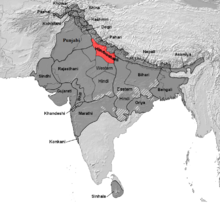Hindi-Urdu
| Hindustani | |
|---|---|
| Hindi-Urdu | |
|
|

The word "Hindustani" in Perso-Arabic script and Devanagari script
|
|
| Native to | Bihar, Chhattisgarh, Delhi, Haryana, Himachal Pradesh, Jharkhand, Madhya Pradesh, Rajasthan, Uttar Pradesh, Uttarakhand |
|
Native speakers
|
329 million (2001) L2 speakers: 215 million (1999) |
|
Standard forms
|
|
| Dialects | |
|
Devanagari (Hindi alphabet) Perso-Arabic (Urdu alphabet) Braille (Hindi Braille and Pakistani Urdu Braille) Kaithi (historical) |
|
| Indian Signing System (ISS) | |
| Official status | |
|
Official language in
|
(as Hindi, Urdu) (as Urdu) (as Fiji Hindi) |
|
Recognised minority
language in |
|
| Regulated by |
Central Hindi Directorate (Hindi, India), National Language Authority, (Urdu, Pakistan); National Council for Promotion of Urdu Language (Urdu, India) |
| Language codes | |
| ISO 639-1 | hi, ur |
| ISO 639-2 | |
| ISO 639-3 | Either: hin – Standard Hindi urd – Urdu |
| Glottolog | hind1270 |
| Linguasphere | 59-AAF-qa to -qf |

Areas (red) where Hindustani (Khariboli/Kauravi) is the native language
|
|
Hindustani (Hindustani: हिन्दुस्तानी,ہندوستانی[ˌɦɪnd̪ʊsˈt̪aːniː], lit. '"of Hindustan"'), historically also known as Hindavi, Dehlvi and Rekhta, is the lingua franca of North India and Pakistan. It is an Indo-Aryan language, deriving primarily from the Khariboli dialect of Delhi, and incorporates a large amount of vocabulary from Sanskrit, Persian, Arabic and Chagatai. It is a pluricentric language, with two official forms, Modern Standard Hindi and Modern Standard Urdu, which are its standardised registers, and which may be called Hindustani or Hindi-Urdu when taken together. The colloquial registers are mostly indistinguishable, and even though the official standards are nearly identical in grammar, they differ in literary conventions and in academic and technical vocabulary, with Urdu adopting stronger Persian, Turkic and Arabic influences, and Hindi relying more heavily on Sanskrit. Before the Partition of the British Indian Empire, the terms Hindustani, Urdu, and Hindi were synonymous; all covered what would be called Urdu and Hindi today. The term Hindustani is still used for the colloquial language and lingua franca of North India and Pakistan, for example for the language of Bollywood films, as well as for several quite different varieties of Hindi spoken outside the Indian Subcontinent, such as Fiji Hindi of Fiji and the Caribbean Hindustani of Trinidad and Tobago, Guyana, Suriname, Jamaica, Barbados, and the rest of the Caribbean. Hindustani is also spoken by a small number of people in Mauritius and South Africa.
...
Wikipedia
